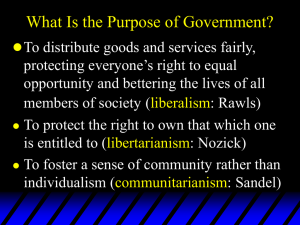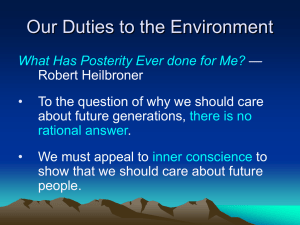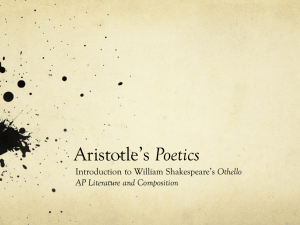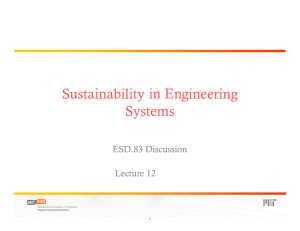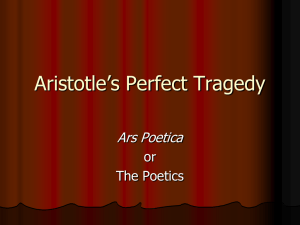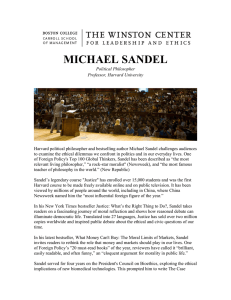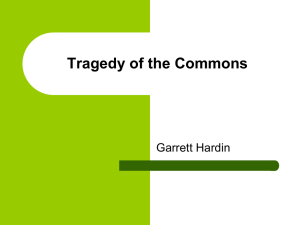Chapter Seven Of the 18,000 objects orbiting Earth, how many are
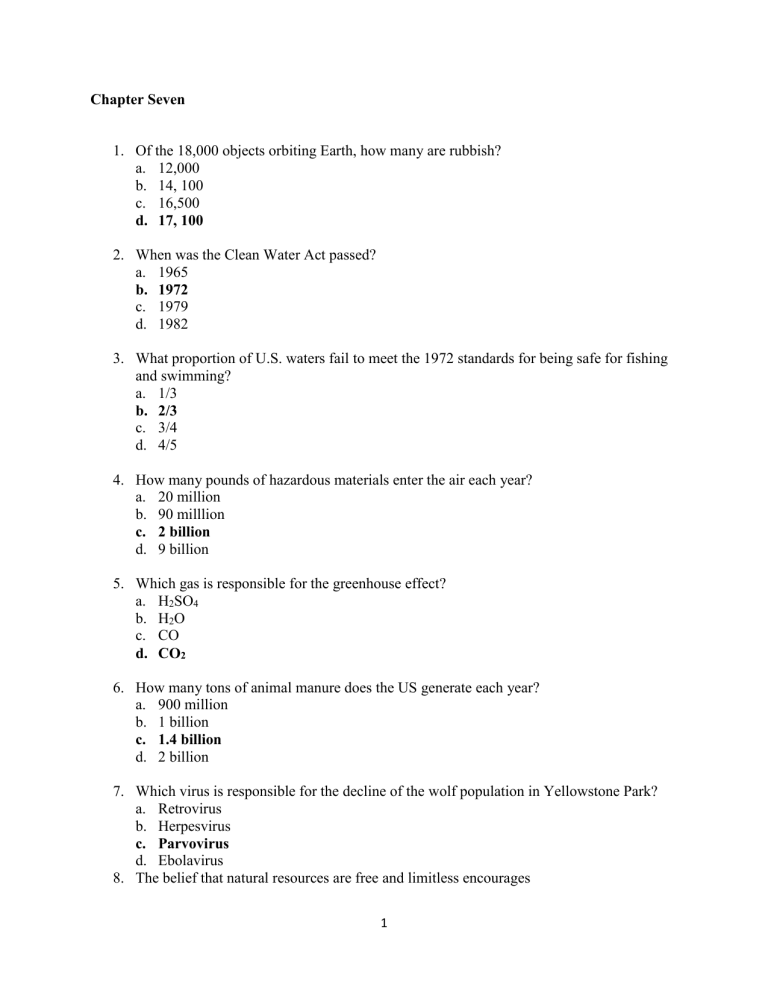
Chapter Seven
1.
Of the 18,000 objects orbiting Earth, how many are rubbish? a.
12,000 b.
14, 100 c.
16,500 d.
17, 100
2.
When was the Clean Water Act passed? a.
1965 b.
1972 c.
1979 d.
1982
3.
What proportion of U.S. waters fail to meet the 1972 standards for being safe for fishing and swimming? a.
1/3 b.
2/3 c.
3/4 d.
4/5
4.
How many pounds of hazardous materials enter the air each year? a.
20 million b.
90 milllion c.
2 billion d.
9 billion
5.
Which gas is responsible for the greenhouse effect? a.
H
2
SO
4 b.
H
2
O c.
CO d.
CO
2
6.
How many tons of animal manure does the US generate each year? a.
900 million b.
1 billion c.
1.4 billion d.
2 billion
7.
Which virus is responsible for the decline of the wolf population in Yellowstone Park? a.
Retrovirus b.
Herpesvirus c.
Parvovirus d.
Ebolavirus
8.
The belief that natural resources are free and limitless encourages
1
a.
Conservation b.
Preservation c.
Wasteful consumption of them d.
Waste management
9.
Which industry exemplifies Hardin’s point about the tragedy of the commons? a.
Car manufacturing b.
International fishing c.
International steel production d.
Clothing manufacturing
10.
How many gallons of water does it take to make an automobile? a.
50, 000 b.
100, 000 c.
150, 000 d.
200, 000
11.
How many gallons of rainwater does America use for every 60 returned by nature? a.
50 b.
65 c.
75 d.
80
12.
In a case in Thailand what was worth 75% more when left to provide natural resources rather than be converted into a fish farm? a.
A mangrove swamp b.
A lake c.
A freshwater estuary d.
A scenic pond
13.
The Interior Department has introduced wolves into a.
Montana, Wyoming, and Nevada b.
Montana, Nevada, and California c.
Montana, Wyoming, and Idaho d.
Wyoming, Nevada, and California
14.
Two popular answers to the question of who should pay the costs of pollution are a.
The taxpayers and industry b.
The Government and industry c.
Those responsible for it and the Government d.
Those responsible for it and those who would benefit from protection and restoration
15.
Who has probably profited more than any other group from treating the environment as a free good? a.
Business
2
b.
Consumers c.
Government d.
Activists
16.
Approximately what proportion of the world’s motor vehicles are owned in the United
States? a.
15% b.
20% c.
25% d.
35%
17.
The United States farm population is now around a.
2% b.
8% c.
12% d.
16%
18.
Which approach to environmental protection makes use of direct pubic regulation and control? a.
The regulatory approach b.
The free market approach c.
The conscription approach d.
The preservation approach
19.
How many toxic contaminants were targeted by the EPA’s 33/50 approach? a.
17 b.
33 c.
45 d.
50
20.
Who believes that it is immoral to buy the right to polute? a.
Michael J. Fox b.
Michael J. Sandel c.
Garrett Hardin d.
John Rawls
21.
Who holds that measures to reduce greenhouse gas emissions need not harm the economy? a.
Sandel and Rawls b.
Sandel and Arrow c.
Rawls and Solow d.
Arrow and Solow
22.
Who discussed the original position in the context of our obligations to future generations?
23.
Annette Baier is concerned with
3
T
T
F
T
T a.
The good of underdeveloped countries b.
The good of the United States c.
The good of the continuing human community d.
The good of utilitarians
T
T
F
F
F
T
T
24.
William F. Baxter recognizes a.
The anthropocentric bias of Baier b.
The anthropocentric bias of his own approach c.
The need to help penguins d.
The need to aid future generations soon
1. Holmes Rolston discusses the naturalistic ethic
2. William F. Baxter is a deep ecologist.
3. The proponents of the naturalistic ethic believe that some natural objects have intrinsic value.
4. Bentham held that something had moral status only if it could reciprocate.
5. Utilitarians focus discussion on animal rights.
6. The LD 50 test is used to test new foodstuffs.
7. Business’ largest impact on animals is through the production of animal-related products.
8. Moral vegetarians object to meat eating on health grounds.
9. Mass production of mea at affordable prices requires factory farming.
10. In Europe it is illegal to treat veal calves the way most American companies do.
11. Garrett Hardin discussed the tragedy of the commons.
12. The concerns of environmental ethics could begin with the food on our plates.
1.
Do you believe that the criterion of moral considerability is that of the ability to suffer?
Would (a) Mill, (b) Kant, agree? Explain each philosopher’s position, and justify your own views in the light of them.
4
2.
How do you believe we should try to reduce pollution? Why do you adopt the position that you do? What (a) moral, and (b) practical advantages do you think it has over the alternative approaches that we might take?
3.
Who do you think should be held responsible for reducing pollution, and/or clearing up currently polluted areas? Why do you adopt the view that you do? How could it be implemented in practice?
4.
What is the “tragedy of the commons”? How might we avert this tragedy? Illustrate your example by drawing on one area in which this tragedy occurs.
5.
Do you believe that we have any obligations to future generations? Why, or why not? If so, explain why you think that we have obligations to beings that do not exist. If not, do you think that we could just pollute as much as we like provided that the effects of our actions would only be felt by future persons? In each case, explain your answer.
6.
Do you believe that natural objects have value in themselves? In answering this question you should explain carefully what it means for something to have (a) instrumental value,
(b) intrinsic value, as well as explaining what would justify the ascription of these different sorts of value to objects and entities.
5
